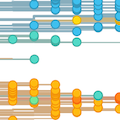Abstract
This report details current seasonal influenza circulation patterns as of Sep 2017 and makes projections up to Sep 2018 to coincide with selection of the 2018 Southern Hemisphere vaccine strain. This is not meant as a comprehensive report, but is instead intended as particular observations that we’ve made that may be of relevance. Please also note that observed patterns reflect the GISAID database and may not be entirely representative of underlying dynamics. All analyses are based on the nextflu pipeline with continual updates posted to nextflu.org.
A/H3N2: H3N2 continues to diversify with many coexisting clades, all of which carry several amino acid mutations at previously characterized epitope sites. The majority of viruses fall into the 3c2.a clade which has been dominating globally for >3 years, but 3c3.a viruses continue to persist. The common ancestor of circulating H3N2 viruses is now more than 5 years old, which is rare for H3N2. Despite extensive genetic diversity, serological assays suggest limited, but non-zero, antigenic evolution. We expect multiple competing clades within 3c2.a to persist into the future with no clear immediate winner.
A/H1N1pdm: A clade comprising mutations S74R and I295V has recently risen to >60% global frequency. Although it shows no antigenic distinction by ferret HI data, the rapidity of its rise suggests a selective origin.
B/Vic: A clade with a two amino acid deletion 162-/163- has altered serological properties and is increasing in frequency, albeit slowly. Two other clades (carrying mutations K209N and V87A/I175V) have increased in frequency moderately.
B/Yam: A clade comprising M251V within clade 3 viruses continues to dominate. The is little genetic differentiation within this clade and no evidence of antigenic evolution.
